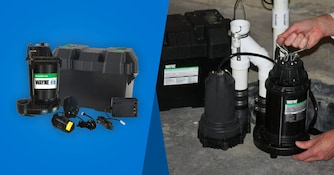
Finding And Fixing Basement Leaks
Drip. Drip. Drip. It's the sound every homeowner fears will come from their basement.
Being the pump expert who answers questions daily about why you need a working
sump pump
system, I can also tell you there are dozens of reasons you could come home to a large puddle in the basement. In the industry, it's what we refer to as "seepage."
The reality is that sometimes unpredictable and seemingly untraceable leaks can occur in your basement where you'd least expect them, and the
unlikely culprits could be as obscure as clogged gutters or a crack in your chimney cap.
But before you drop a fortune on costly repair services and hope the problem gets fixed, embrace the spirit of a true DIYer first and try diagnosing the cause yourself using this troubleshooting guide. We want to help you get to the root cause of the problem, not mask it.
What is Seepage, and Where is it Found?
"Seepage" happens when moisture slowly escapes through small holes or passes through porous materials. It is also referred to as chronic leaking and occurs in dark, cool, or damp places like the basement. At the source, these chronic leaks are caused in one way or another by rainfall, and not by flooding or natural disasters.
If you're wondering what to do if your basement floods, we've also written an
ultimate flooding guide
that explains what to do before and during a flood, and steps on how to clean up after a flood.
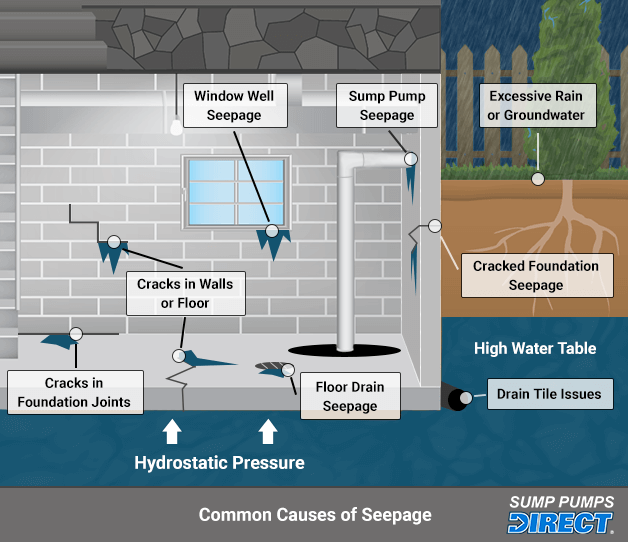
Common Causes of Moisture in the Basement:
- Hydrostatic pressure in walls or basement floor
- Cracks in walls or basement floor
- Cracks in foundation joints
- Foundation/foundation walls not high enough
- Window seal or window well seepage
- Sump pump issues
- Drain tile or sump pit issues
- Interior water leaks
- Ineffective downspouts or gutters
- Grading of yard and house
- Excessive rain or groundwater from seasonal thawing
- High water table
- Piping or plumbing sources
How to Find a Leak in Your Basement
Water has a funny way of flowing into the smallest of spaces, in places you wouldn't expect to find it. Leaking or seeping problems are very difficult to track down when the water trails have dried up or the leaks seem to occur behind walls or under the floor. In fact, there are dozens of possibilities you may not have thought to check for before.
Below we explore common and some uncommon sources of moisture and ways to fix the problem, starting from the top (the roof) to the bottom (basement).
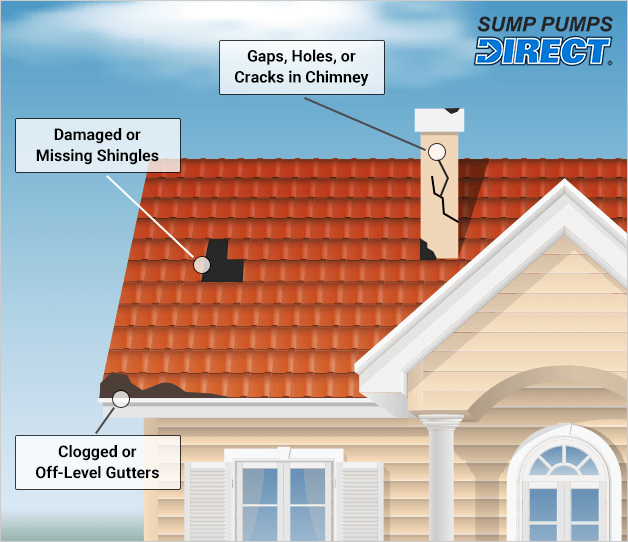
Check Rooftops, Shingles, and Chimneys
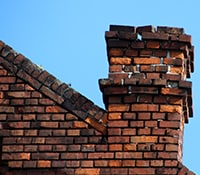 The shingles on your roof are your home's first line of defense meant to protect your home from water by guiding rainfall into your newly-cleaned gutters. However, shingles will start to break down over time, becoming less waterproof as water finds ways to trickle underneath weak or damaged spots.
The shingles on your roof are your home's first line of defense meant to protect your home from water by guiding rainfall into your newly-cleaned gutters. However, shingles will start to break down over time, becoming less waterproof as water finds ways to trickle underneath weak or damaged spots.
Your home may have one or more chimneys that are primarily meant to exhaust smoke from fires and vent gases from a furnace. A quick roof inspection can discover that the waterproofing on a chimney and its cap isn't as good as it should be. Similarly, a visual inspection of the vents of your heating equipment can provide clues if water spots are left behind.
Make sure to check your chimney and cap for cracks, metal connections, flashing, and even your flue. In many homes, the chimney runs all the way down into the basement, which is a direct shot from the sky to the basement floor.
How to Fix a Leaking Chimney or Shingles
If you find that your shingles are turned-up and have become brittle, or find black residue in your gutters, the shingles on the roof are likely breaking down and should be inspected closely for damage and leaks. Beware of quick fixes with lofty claims, like waterproofing agents. They will not remedy a failing roof. More likely, your roof may need a re-shingle, but a full roof replacement may be necessary.
If you find tiny gaps in and around your chimney, or small holes on the top of the cap, you can buy repair sealant in most hardware stores. You can also apply a waterproofing solution around your bricks and around your flashing to make sure your chimney is properly water-sealed. If you find cracks or damaged flashing it's best to call a professional to repair the problem.
Check the Gutters
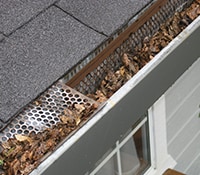 No one wants blocked gutters. You'll want to make sure your gutters are always clear and that the runoff spouts run far enough from your home so the water can't backflow into your basement.
No one wants blocked gutters. You'll want to make sure your gutters are always clear and that the runoff spouts run far enough from your home so the water can't backflow into your basement.
Additionally, if the gutters are off-level and tend to pool in certain places, leaks are more likely to occur during rain or storms. Make sure the angles of all gutters appropriately direct water toward the downspouts and not allowing water to pool. Clips and brackets may need to be installed to correct leveling issues.
How to Fix Clogged Gutters
Sometimes this fix is a simple as using a pressure washer to clean clogged gutters. Simpler still is a ladder and some heavy-duty gloves. The important thing is to make sure all debris is cleaned out, and getting additional protection so they never clog again. If you find black residue in your gutters, you need to check your aforementioned shingles.
An easy addition to a gutter system is to add gutter extensions to your downspouts. That way, water is transported away from your foundation. A great investment is to purchase gutter guards that allow water but nothing else to pass through, ensuring that the water doesn't back up from clogged debris and spill down the sides of your house instead of running all the way through the gutter to the exit spout.
Landscape Grading
 Often overlooked, the grade or "pitch" of your home on your property should be inspected. A home should be on a small crown (higher than the surrounding property) at least 6 inches above the rest of your land near the home. Over time, this grade can decline, causing your house to sink slightly and lessen the grade.
Often overlooked, the grade or "pitch" of your home on your property should be inspected. A home should be on a small crown (higher than the surrounding property) at least 6 inches above the rest of your land near the home. Over time, this grade can decline, causing your house to sink slightly and lessen the grade.
Homes in areas with high water tables can contribute to chronic leaking problems as well.
To test the pitch of your home, you can plant stakes 12 inches apart from your home to the edge of your property and attach a string to the top of each stake. Measure and mark a line on the bottom of the stake so you can insert the stakes at the same depth in the ground for accuracy.
Additionally, your landscaping could prevent water from being moved far enough away from your downspout, and instead, the water could be backflowing toward your foundation.
Another less-common issue could be with any kind of underground sprinkler system, causing excess water to move along the water table toward your foundation. This is harder to diagnose and may require a professional to examine.
How to Fix Home Grading and Landscaping
Rainwater should always flow away from your home. To fix a sagging home-grade, you can add soil around your home to re-create a grade that water will run when it rains. You can also re-shape the landscaping to help redirect water from other places around your property without it ever reaching your home. But, make sure the ground around your home is at least a few inches below the sill plate, or where the home sits atop the foundation. This a very common source of seepage.
Creating a 'berm mound' or 'swale' ditch can help with those issues as well. These jobs can generally be done for a few hundred dollars by a professional, and less if done by yourself. Planting trees or even a fence can help deter groundwater from running directly toward your home.
Windows, Window Wells, and Seals
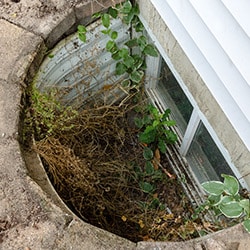 Checking windows for leaks is often harder because most of the time it takes a rainstorm to see from where the water may be leaking. Also, droplets of water can drip from the window edge and away from the wall, making watermarks or obvious signs of seeping difficult to spot.
Checking windows for leaks is often harder because most of the time it takes a rainstorm to see from where the water may be leaking. Also, droplets of water can drip from the window edge and away from the wall, making watermarks or obvious signs of seeping difficult to spot.
Make sure to check the outdoor window wells. If your window well already has a drain at the bottom, clean it out. If it doesn't, you may need to make one to
divert the water further away from the home. Window well liners have also been known to separate over time and could cause a gap between your well and foundation wall.
How to Fix Leaking Windows and Seals
Often times, window and seal leaks can be easily corrected by using a waterproofing or water sealing caulk sold at your local hardware store. Be sure to apply caulk on the outside as well as the inside of the window. Also, check to make sure there are no hairline cracks in any windows, as basement windows tend to be thinner-sheet panes.
Cracks in the Basement Floor or Joints
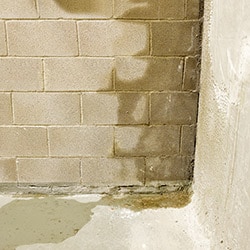 Check the entire visible surface of your floor for signs of water stains, moisture,
Check the entire visible surface of your floor for signs of water stains, moisture,
dripping, or rust discoloration. Be aware that cracks could be concealed behind these walls too, so locating the source could be difficult. One of the most common causes of chronic basement seepage is hydrostatic pressure building up under the foundation and soil, causing cracks from shifting or increased pressure. Minimizing hydrostatic pressure in your basement is critical if you've been facing constant leaking after rain or seasonal thawing.
As hydrostatic pressure builds under your basement floor, the soil below builds horizontal pressure and expands as the absorbed water migrates (or leak upwards) through your foundation and makes its way onto the surface of your basement floor, or up adjacent walls. This is a common occurrence in areas with softer soil, which absorbs more water from the water table and during heavy rainfall.
How to Fix Cracks in Basement Floors
Immediate fixes include using waterproofing sealant (usually polyurethane concrete sealant) or installing a basement waterproofing kit that looks like floor molding and waterproofs floor-to-wall seepage.
More in-depth fixes include installing/fixing a drain tile system, which is much more complicated and usually requires professional diagnosis and contractor work. A benefit of a drain tile system is that gutters, walls, window wells, and more can be fitted with piping that connects directly to your sump pump pit.
Wall and Floor Joints: the area where the walls and floor joins is a common area where seepage occurs. If these areas are routinely leaking, additional waterproofing at the cracks should help.
Wall Leakage
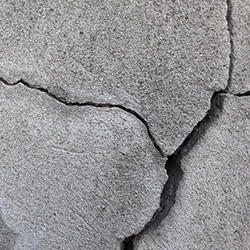 We often forget that behind basement foundation walls is simply water and earth from under the ground. Check for damage and stains on any parts of your basement walls, whether they are concrete or drywalled. Check beneath and around windows along the walls as well.
We often forget that behind basement foundation walls is simply water and earth from under the ground. Check for damage and stains on any parts of your basement walls, whether they are concrete or drywalled. Check beneath and around windows along the walls as well.
How to Fix Leaking Walls
We recommend investigating further to make sure these suggestions aren't just a band-aid solution for a larger problem. However, a simple way to repair small, hairline cracks in concrete walls is to use a polyurethane waterproofing concrete sealant that you can get from any major hardware store. The best way to apply the sealant is with a caulk gun to save you time and trouble.
If you find any water stains on drywall, you'll likely need to remove that part of the wall for a closer inspection of the problem. Be mindful of electrical wiring and piping behind the wall as you cut a portion out using a drywall knife. Cut a square around small stains so you can replace the piece with mesh. For larger stained areas, cut stud-to-stud so you can replace the damaged panel afterward.
Check All Piping in the Basement
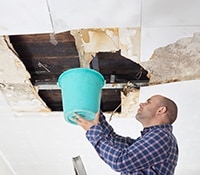 Check the ceiling for water stain damage. Remove ceiling tiles (if applicable) and inspect the piping above for drips or loose water running along the pipe. Check the underside of the ceiling panels for water stains or other signs of past dripping.
Check the ceiling for water stain damage. Remove ceiling tiles (if applicable) and inspect the piping above for drips or loose water running along the pipe. Check the underside of the ceiling panels for water stains or other signs of past dripping.
If you have a bathroom in your basement, you'll need to check those pipes as well for obvious signs of leaking into other parts of your basement. Additionally, appliances that use water piping (like your washing machine) need to be inspected too. Sometimes HVAC systems or dryers can cause condensation in cool basements that can create puddles of water.
How to Fix Leaking Basement Pipes
If it's a slow leak or a leak caused by condensation on your pipes, plumbers tape and waterproofing pipe putty or other sealants should do the trick. If the issue is condensation from hot water pipes, pipe insulation can help prevent moisture drips.
When it comes to plumbing, remember to check all of the joints for cracks, leaks, and signs of breaking down at the connections. Replacing a specific plumbing joint isn't as difficult as replacing a burst pipe.
Why You Need to Update Your Sump Pump
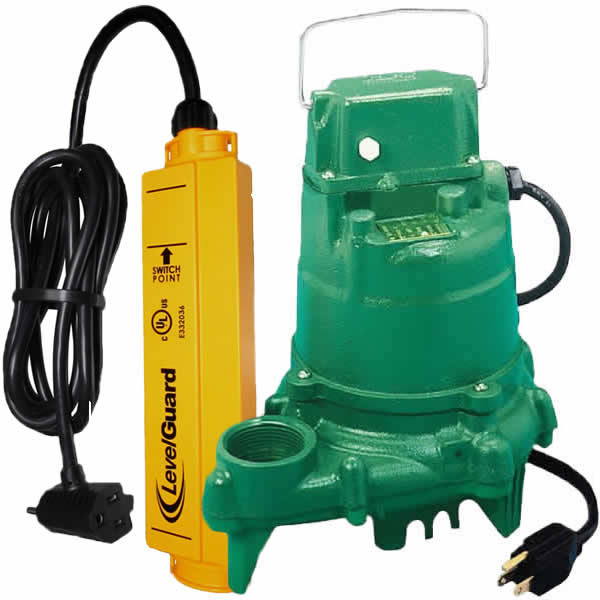 No matter what the cause of chronic leaking in your basement is, responsible homeowners should ensure that their sump pump is working properly before major basement flooding occurs due to any of the above causes. A sump pump is the first and often the last line of defense for water flooding the basement. Learn how to replace your sump pump
No matter what the cause of chronic leaking in your basement is, responsible homeowners should ensure that their sump pump is working properly before major basement flooding occurs due to any of the above causes. A sump pump is the first and often the last line of defense for water flooding the basement. Learn how to replace your sump pump
yourself to ensure your pump is ready when you need it.
The next but often overlooked line of defense in a sump pump system is a backup sump pump that will still operate if your home loses power in bad weather. There are also combination sump pump systems that are easy installation upgrades for those who are adding a backup pump and replacing their primary sump pump. Combination systems operate together as a primary pump and the backup pump will activate when needed.
Lastly, no system is complete without a working sump pump alarm. These systems notify you when anything goes wrong with your pump, whether the power goes out, the battery backup kicks on, or if your pump can't remove water fast enough. This is a necessity for preventing basement flooding during times you can be proactive to prevent your sump pit from overflowing.
To make things even easier, sump pump systems now come with wi-fi alarm options and smart sump pump systems-so you can get notifications directly on your phone that alert you to exactly what is wrong.
At the end of the day, your sump pump, sump pit, and drain tile system will manage most leaking and flooding issues your basement may encounter, so it's best not to neglect these systems until tragedy strikes. Hopefully, you've found the answer to why your basement was experiencing leaks, and have taken steps to correct the problem and effectively waterproofed your basement. Now that you're done troubleshooting, it's time to protect your basement from future leaks.
![]()
NEXT: How to Prevent Basement Flooding




